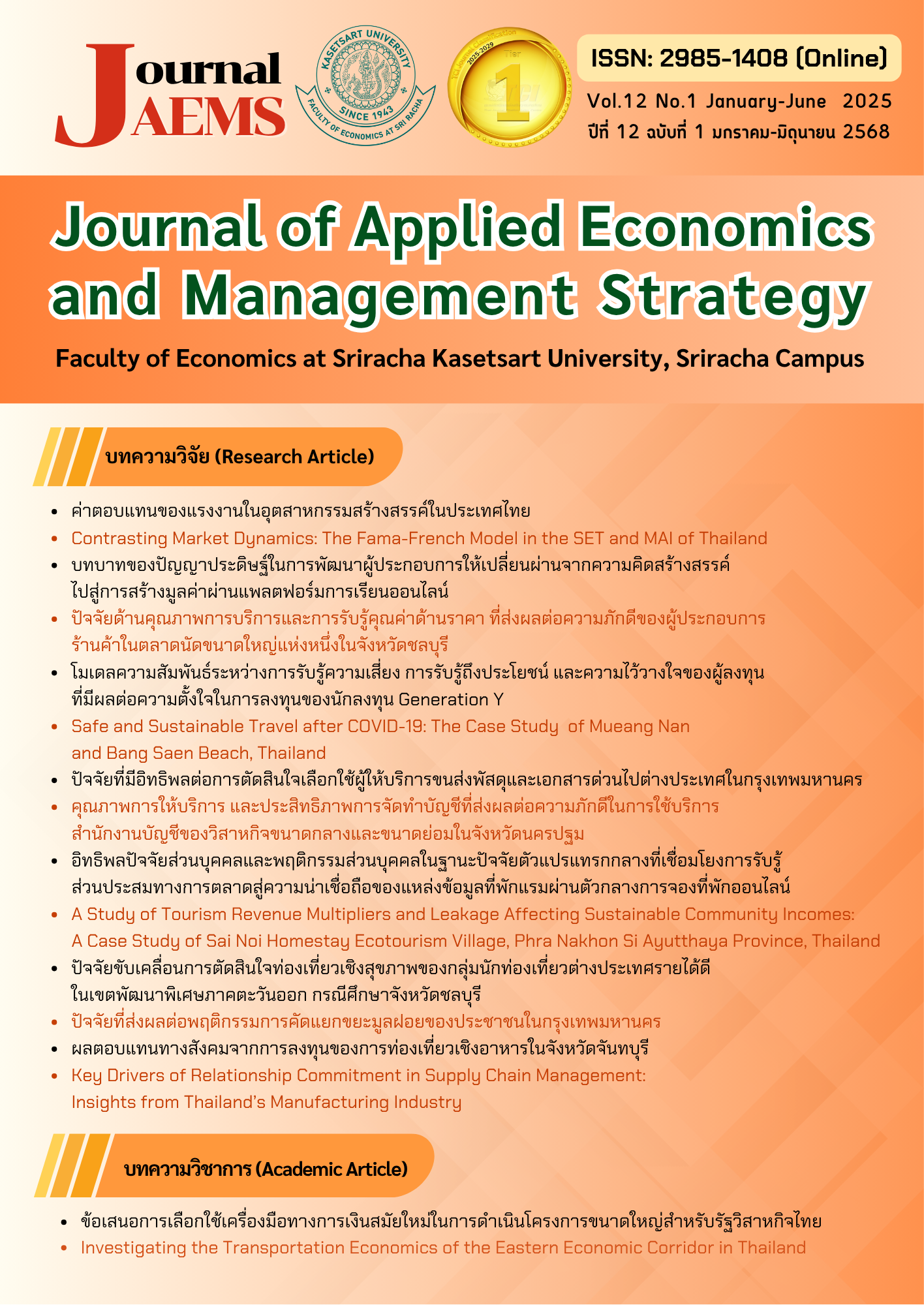Investigating the Transportation Economics of the Eastern Economic Corridor in Thailand
Main Article Content
Abstract
This paper investigates the transportation economics of Thailand's Eastern Economic Corridor (EEC), highlighting significant challenges and potential solutions. Rapid economic development and increased industrial activities in the EEC have led to problematic transportation issues, including traffic congestion and environmental degradation. This study examines the interplay of supply and demand, opportunity costs, and externalities in the context of EEC's transportation challenges. Three economic solutions are explored: congestion pricing, Pigouvian environmental taxes, and subsidies for non-substitutable modes. Congestion pricing, successfully implemented in cities like London and Singapore, aims to reduce traffic by charging fees during peak hours, thus internalizing the external costs of driving. Pigouvian taxes, such as those in Sweden and British Columbia, target vehicle emissions to align private costs with social costs, encouraging cleaner transportation alternatives. Subsidies are proposed to promote the use of less polluting transport modes, shifting demand from private cars to public transportation. The paper underscores the importance of local community participation in policy-making to ensure equitable and practical solutions. By adopting these economic tools, the EEC can achieve more sustainable urban mobility and improved environmental quality, balancing economic growth with environmental preservation.
Downloads
Article Details

This work is licensed under a Creative Commons Attribution-NonCommercial-NoDerivatives 4.0 International License.
References
ASEAN Business News. (2018). Thailand’s Eastern Economic Corridor – What You Need to Know. Retrieved from https://www.aseanbriefing.com/news/thailands-eastern-economic-corridor-need-know
Bangkok Post. (2023). 3-airport high-speed rail link completion seen by 2029. Retrieved from https://www.bangkokpost.com/business/2207475/3-airport-high-speed-rail-link-completion-seen-by-2029
Bardi, E. J., Coyle, J. J., & Novack, R. A. (2006). Management of Transportation. South-Western, part of the Thompson Corporation
Bazrbachi, A., Sidique, S. F., Shamsudin, M. N., Radam, A., Kaffashi, S., & Adam, S. U. (2017). Willingness to pay to improve air quality: a study of private vehicle owners in Klang Valley, Malaysia. Journal of cleaner production, 148, 73-83. https://doi.org/10.1016/j.jclepro.2017.01.035
Board of Investment (BOI). (2020). Thailand’s Eastern Economic Corridor – What You Need to Know. ASEAN Briefing. Retrieved from https://www.aseanbriefing.com/news/thailands-eastern-economic-corridor-need-know
Board of Investment (BOI). (2024). Thailand’s Electric Vehicle Policy and Investment Measures. Retrieved from https://www.boi.go.th
Chen, L., Shi, M., Li, S., Gao, S., Zhang, H., Sun, Y., ... & Zhou, J. (2017). Quantifying public health benefits of environmental strategy of PM2. 5 air quality management in Beijing–Tianjin–Hebei region, China. Journal of Environmental Sciences, 57, 33-40. https://doi.org/10.1016/j.jes.2016.11.014
Deloitte. (2024). 2024 Thailand’s Economic Outlook and Emerging Technology Trend. Retrieved from https://www2.deloitte.com
Department of Land Transport. (2024). Thailand Motor Vehicle Newly Registered: LTA: Eastern: Chachoengsao, Chonburi, and Rayong. Retrieved from https://www.dlt.go.th
Development Asia. (2023). The Case for Electronic Road Pricing. Retrieved from https://www.development.asia
Government of British Columbia. (2023). British Columbia’s Carbon Tax. Retrieved from https://www2.gov.bc.ca
Government of Sweden. (2023). Sweden’s Carbon Tax. Retrieved from https://www.government.se
Harvard University Graduate School of Design. (2016). Congestion Pricing in Stockholm. Retrieved from https://research.gsd.harvard.edu/tut/files/2016/06/Stockholm-Case-2016.pdf
Johnston, R. J., Boyle, K. J., Adamowicz, W., Bennett, J., Brouwer, R., Cameron, T. A., ... & Tourangeau, R. (2017). Contemporary guidance for stated preference studies. Journal of the Association of Environmental and Resource Economists, 4(2), 319-405. https://doi.org/10.1086/691697
Kenneth, B. (2010). Transport economics (3rd ed.). Cheltenham, UK: Edward Elgar Publishing.
Khamkaew, C., Chintakovid, N., Tantisarasart, R., Buasong, S., & Bualert, S. (2022). Outpatient Department Visits and Mortality with Various Causes Attributable to Ambient Air Pollution in the Eastern Economic Corridor of Thailand. International Journal of Environmental Research and Public Health, 19(14), 7683. https://doi.org/10.3390/ijerph19147683
Kim, K. H., Kabir, E., & Kabir, S. (2015). A review on the human health impact of airborne particulate matter. Environment international, 74, 136-143. https://doi.org/10.1016/j.envint.2014.10.005
Kolstad, C. D. (2000). Environmental economics. New York, NY: Oxford University Press.
Kudun, S., Schooneman, T., Vachiravarakarn, K., & Sapsutthiporn, M. (2021). Investing in the Future: Thailand’s Eastern Economic Corridor (EEC). Retrieved from https://www.kap.co.th
Lelieveld, J., Evans, J. S., Fnais, M., Giannadaki, D., & Pozzer, A. (2015). The contribution of outdoor air pollution sources to premature mortality on a global scale. Nature, 525(7569), 367. https://doi.org/10.1038/nature15371
Liu, Z., Hanley, N., & Campbell, D. (2020). Linking urban air pollution with residents’ willingness to pay for greenspace: A choice experiment study in Beijing. Journal of Environmental Economics and Management, 104, 102383. https://doi.org/10.1016/j.jeem.2020.102383
Muenmee, S., & Bootdee, S. (2021). Health risk assessment of exposure PM2.5 from industrial area in Pluak Daeng district, Rayong province. Naresuan Phayao Journal, 14(3), 95-110.
National Economic and Social Development Board. (2016). Thailand 4.0. Retrieved from https://www.nesdb.go.th/nesdb_en/main.php?filename=index
Office of the National Economic and Social Development Council (NESDC). (2023). Thailand Economic Monitor: July 2024. Retrieved from https://www.nesdc.go.th
Office of the National Economic and Social Development Council (NESDC). (2024). EEC Economic Quarterly Report. Retrieved from https://www.nesdc.go.th
Parliament of the United Kingdom. (2011). Taxation of road fuels: the road fuel escalator (1993-2000). Retrieved from https://kasets.art/MQJzwU
Pholgerddee, P., Ngakasam, R., & Mahaman, K. (2021). Study of air allergy from particulate matter 10 micrometers (PM10): A case study of Eastern Economic Corridor (EEC). Rajamangala University of Technology Suvarnabhumi Journal of Science and Technology, 5(2), 23-32.
Transport for London. (2023). London's Congestion Charge celebrates 20 years of success. Retrieved from https://www.intelligenttransport.com
United Nations Environment Programme. (2017). Actions on air quality. Retrieved from https://kasets.art/ClXrj3
World Bank. (2016, June 1). The Cost of Air Pollution Strengthening the Economic Case for Action. Retrieved from https://kasets.art/wTf6RV
World Health Organization. (2018). Burden of disease from the joint effects of household and ambient air pollution for 2016. Retrieved from http://www.who.int/airpollution/data/AP_joint_effect_BoD_results_May2018.pdf?ua=1
Zahedi, S., Batista-Foguet, J. M., & van Wunnik, L. (2019). Exploring the public's willingness to reduce air pollution and greenhouse gas emissions from private road transport in Catalonia. Science of the total environment, 646, 850-861. https://doi.org/10.1016/j.scitotenv.2018.07.361
